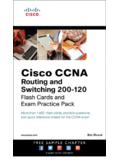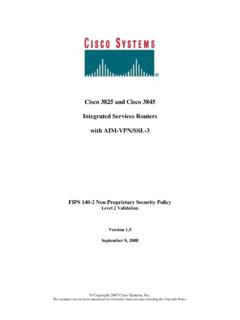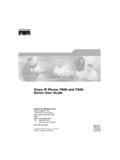Transcription of This document is exclusive property of Cisco …
1 this document is exclusive property of Cisco Systems, Inc. Permission is granted to print and copy this document for noncommercial distribution and exclusive use by instructors in the CCNA 1: Networking Basics course as part of an official Cisco Networking Academy Program. 1 - 211 CCNA 1: Networking Basics Instructor Guide Course Overview Copyright 2004, Cisco Systems, Inc. I. Welcome Welcome to the CCNA 1 version Instructor Guide. this guide is designed to make teaching the CCNA 1 course a little easier. As an introduction to this guide, four themes will be emphasized. Student-centered, instructor-facilitated The CCNA curriculum has not been designed as a stand-alone e-learning or a distance-learning course. The Cisco Networking Academy Program is based on instructor facilitation. The diagram "Learner Model: Academy Student" summarizes the emphasis that Cisco Worldwide Education (WWE) puts on the student. The instructor utilizes activities, built from a variety of resources, to help the students achieve desired understandings of networking.
2 One curriculum does not accommodate all students The Cisco Networking Academy Program is used by hundreds of thousands of students in almost 150 countries. Students vary from teenagers to mature adults, at different levels of education. One curriculum cannot be perfect for all students. The local instructors utilize the learning goals of the program, and the resources described in the learner model to make the program work for their specific students. Instructors are given the following reference points to plan their instruction: Mission of WWE to educate and train Requirements of the CCNA certification exam Hands-on skills that help make students ready for industry and further education The policy of WWE is to support additions to the curriculum, but not the removal of any of the curriculum. In-class differentiation is encouraged. Here, struggling students are given remediation and high-achieving students are given further challenges. The instructor decides how much time to spend on various topics.
3 Depending on the students, some topics can be 2 - 211 CCNA 1: Networking Basics Instructor Guide Course Overview Copyright 2004, Cisco Systems, Inc. emphasized and other topics can be covered with less emphasis. Only the local instructor can decide how to balance the need to do hands-on labs with the realities of the local student-to-equipment ratio and time schedule. Using this guide may facilitate preparation of lesson plans and presentations. Instructors are strongly encouraged to research and use external sources and develop in-house labs and exercises. To assist the instructor in course and lesson planning, certain Target Indicators (TIs) have been emphasized for particular importance. However, these TIs are not the only ones that need to be taught. Often an emphasized TI will only make sense if preceding TIs are understood. It may be useful to have a diagram of the TIs that best emphasize the knowledge and skills that are needed for success in the CCNA program.
4 Assessment is multifaceted and flexible. A wide variety of assessment options exist to provide feedback to the students and document their progress. The Academy assessment model is a blend of formative and summative assessments that include online and hands-on skills-based exams. Appendix B summarizes the official Academy assessment policy. Appendix C describes the "Claims and Evidence" approach, which is the basis for the entire assessment system design. Hands-on, skills-based The core of the CCNA 1 experience is a sequence of hands-on labs. Each lab has been designated as either core or optional. Essential Labs must be completed. They are fundamental to the CCNA Academy student experience, certification test requirements, job success, and cognitive and affective development. In CCNA 1, students must master interconnecting PCs, hubs, switches, routers, Ethernet cables, and serial cables to have Layer 1 connectivity across a network. The Cisco community Cisco instructors are members of a global community of educators.
5 More than 10,000 individuals are actively teaching the CCNA and CCNP courses. Instructors are encouraged to take advantage of this community through their Regional Academies (RAs), Cisco Academy Training Center (CATC), the Cisco Academy Connection, and through other forums. It is the commitment of WWE to improve the curriculum, assessment, and instructional resources. Feedback can be submitted through the Cisco Academy Connection. Please continue to check the Cisco Academy Connection for regular releases of instructional materials. Guide overview Section II, Course Overview , provides a scope and sequence type overview of the course. Section III, Guide to Teaching TI by TI , summarizes the most important learning objectives, target indicators, and labs. this section also offers teaching suggestions and background information. Section IV, Case Study , provides an overview to the Structured Cabling Case Study and Wiring Project. Section V, Appendixes , includes Cisco Online Tools and Utilities , CCNA Assessment Guidelines , Evidence Centered Design of Assessment Tasks in the Networking Academy , and Instructional Best Practices.
6 Three additional materials that come with this guide to provide help with teaching the CCNA 1 course: Instructor Lab Manual this document contains instructor versions of labs, including lab solutions. Student Lab Manual this document contains student versions of labs. Skills-Based Assessment this document provides examples of what is expected as a final performance-based assessment for the CCNA 1 course. 3 - 211 CCNA 1: Networking Basics Instructor Guide Course Overview Copyright 2004, Cisco Systems, Inc. II. Course Overview Target Audience The target audience is anyone who desires a practical, technical introduction to the field of networking. this includes students of all levels who are interested in careers as network technicians, network engineers, network administrators, and network help-desk staff. Prerequisites The successful completion of this course requires the following: Reading level of 13-years-old or higher Basic computer literacy and awareness of the Internet The following skills are beneficial, but not required: Prior experience with computer hardware, binary math, and basic electronics Background in cabling Course Description CCNA 1: Networking Basics is the first of four courses leading to the Cisco Certified Network Associate (CCNA) designation.
7 CCNA 1 introduces Cisco Networking Academy Program students to the networking field. The course focuses on the following: Network terminology Network protocols Local-area networks (LANs) Wide-area networks (WANs) Open System Interconnection (OSI) model Cabling Cabling tools Routers Router programming Ethernet Internet Protocol (IP) addressing Network standards In addition, the course provides instruction and training in the proper care, maintenance, and use of networking software, tools, and equipment. Course Objectives The CCNA certification indicates knowledge of networking for the small office, home office (SOHO) market. The certification also indicates the ability to work in small businesses or organizations using networks that have fewer than 100 nodes. 4 - 211 CCNA 1: Networking Basics Instructor Guide Course Overview Copyright 2004, Cisco Systems, Inc. A qualified CCNA should be able to perform the following tasks: Install and configure Cisco switches and routers in multiprotocol internetworks using LAN and WAN interfaces Provide Level 1 troubleshooting service Improve network performance and security Perform entry-level tasks in the planning, design, installation, operation, and troubleshooting of Ethernet and TCP/IP networks The CCNA 1 course is an important step toward achieving CCNA certification.
8 Upon completion of this course, students will be able to perform tasks related to the following: Networking mathematics, terminology, and models Networking media such as copper, optical, and wireless LAN and WAN testing and cabling Ethernet operation and 10, 100, or 1000-Gb versions of Ethernet Ethernet switching IP addressing and subnetting IP, TCP, UDP, and application layer protocols Lab Requirements Please refer to the latest CCNA equipment bundle spreadsheets on the Academy Connection site. Certification Alignment The curriculum is aligned with the Cisco Internet Learning Solution Group (ILSG) CCNA Basic (CCNAB) and Interconnecting Cisco Network Devices (ICND) courses. CCNA 1 Course-Level Claims A competent student will be able to perform the following tasks: Describe and install the hardware and software required to be able to communicate across a network. Demonstrate the mathematical skills required to work with decimal, binary, and hexadecimal numbers.
9 Define and describe the structure and technologies of computer networks. Describe the meaning and application of bandwidth when used in networking. Describe, compare, and contrast network communications using two examples of layered models. Describe the physical, electrical, and mechanical properties and standards associated with copper media used in networks. Describe the physical, electrical, and mechanical properties and standards associated with optical media used in networks. Describe the standards and properties associated with the transmission and reception of wireless signals used in networks. 5 - 211 CCNA 1: Networking Basics Instructor Guide Course Overview Copyright 2004, Cisco Systems, Inc. Describe what is required to install a simple WLAN. Explain the issues associated with the transmission of signals on networking media. Describe the topologies and physical issues associated with cabling common LANs.
10 Describe the physical issues associated with cabling networking equipment to work over a WAN link. Explain the fundamental concepts associated with the Ethernet media access technique. Explain how collisions are detected, and the concepts associated with auto-negotiation on an Ethernet system. Describe the principles and practice of switching on an Ethernet network. Compare and contrast collision and broadcast domains, and describe the process of network segmentation. Explain and demonstrate the mechanics associated with IP addressing. Describe how an IP address is associated with a device interface, and the association between physical and logical addressing. Explain and demonstrate the mechanics associated with IP subnetting. Describe the principles and practice of packet switching utilizing IP. Describe the concepts associated with routing and the different methods and protocols used to achieve it. Describe how the protocols associated with TCP/IP allow host communication to occur.




